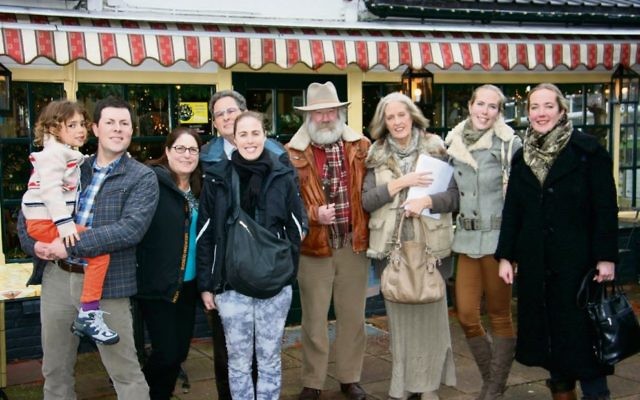‘The brave people who saved my grandma’
LITTLE did my father, Martin Moen, know that a chance visit in 1990 to a Dutch war memorial in Loosdrecht, the Netherlands, would trigger such a significant sequence of events, writes Rebecca Moen.

LITTLE did my father, Martin Moen, know that a chance visit in 1990 to a Dutch war memorial in Loosdrecht, the Netherlands, would trigger such a significant sequence of events, writes Rebecca Moen.
Over the next few decades, he unravelled the story of his mother and her immediate and extended family’s experiences during World War II. My father’s unwavering determination, along with the positive impact on current generations, make this story of remembrance quite unique.
My grandma, Erica Moen (nee Deen), was 16 when the war broke out in the Netherlands. In 1942, Erica and her immediate family went underground. And this is where the story begins.
They were hidden in towns, villages and farms through myriad connections with the Dutch Underground and devout Dutch Christians. Her extended family were not so fortunate, as the majority were forced from their Amsterdam homes, transported to northern Holland and then to the gas chambers.
Erica escaped capture and certain death on numerous occasions as she made her way from one hiding place to another. She survived three-and-a-half years of terror, hiding in fields, straw bales, attics and church vaults, and being shot at.
She was directly protected by five families and countless others. Protectors included Jan and Dinnie van Zutphen, Hendrik and Wilhelmina Grootemarsink and Pastor Cornelius and Marianna Keers.
Erica’s mother, father, younger brother and two sisters were hidden and miraculously survived. Her other siblings, Harold and Rebecca, were murdered at Sobibor on the same day. I am named after Rebecca and believe her memory lives on through me.
As my father pieced together his family’s experiences during the war, he felt a growing sense that the protectors must be remembered. Not only as he and his family would otherwise not be here today, but the need for something positive to come from such a terrible atrocity.
It took 20 years to gather all the information on his mother’s story and immediate family. He tried on a few occasions for Yad Vashem to recognise their wartime protectors, but each time, the information was not quite sufficient.
Many would have given up, but my father persisted, determined there would be recognition. He also had an innate sense that he must somehow make contact with the relatives of his mother’s protectors, and meet them.
It was not until 2012 that my father made significant progress. Prior to a holiday in the Netherlands, he spoke with Wolter Keers, one of Pastor Keers’s sons. Walter suggested that he take my father and mother to all of Erica’s hiding places.
This sequence of events was significant as my father was able to piece together the remaining parts of the story and make a robust submission to Yad Vashem, which was accepted.
In late 2013, my father, mother, brother, niece and I travelled to Amsterdam. We attended a ceremony co-hosted by Yad Vashem to officially recognise the 10 Dutch Righteous Amongst the Nations families who saved Erica during the war.
With over 50 guests, representing four generations, it was an emotional tribute to the brave men and women. It was incredible to meet the sons, daughters, grandchildren and great-grandchildren of all the Righteous families. Lifelong friendships were formed and my father is in regular contact with these families who he now sees as an extension of his own family.
A recent visit to Yad Vashem in Israel by Lourens Keers (son of Wolter Keers) is a testament to these strong connections. Three generations stood in the garden dedicated to the memory of the Righteous Amongst the Nations. They were overwhelmed with emotion, both sadness and an immense feeling of pride, to see their families’ names on the Dutch Wall.
But the story of remembrance does not end there. Upon retirement, my father decided to dig deeper into his family tree. Once again he had that characteristic sense that there was something missing. What happened to all of his mother’s extended family during the war? Why did so many of their names not appear on any of Yad Vashem’s records, let alone in the Pages of Testimony?
He made contact with Yad Vashem and started working with Sara Berkowitz, head of the Names Recovery Project. Pages of Testimony are special forms created by Yad Vashem and differ from commemorative lists. They are symbolic “tombstones” and for many Holocaust survivors and families they are the only tangible evidence that their murdered loved ones ever lived.
Guided by Sara, my father and Edna Shmueli, a remarkable Yad Vashem volunteer, set about researching and creating Pages of Testimony. The results were astounding. When my father reached 1000 names of extended family, he couldn’t quite believe it.
Edna checked these names against Yad Vashem’s records and the results were incredible. Approximately 15 per cent of the names were new, as they did not appear in any of Yad Vashem’s records. Another 70 per cent of the names, although mentioned in a memorial list, did not have a Page of Testimony to commemorate them.
My father is currently working with Edna to create Pages of Testimony for all of his extended family. Through his perseverance, he will ensure his murdered family will never be forgotten.
Rebecca Moen is the daughter of Martin Moen who has extensively researched how his family was saved by Dutch people during the Holocaust. She acknowledges the cooperation of Yad Vashem in compiling this article.

comments